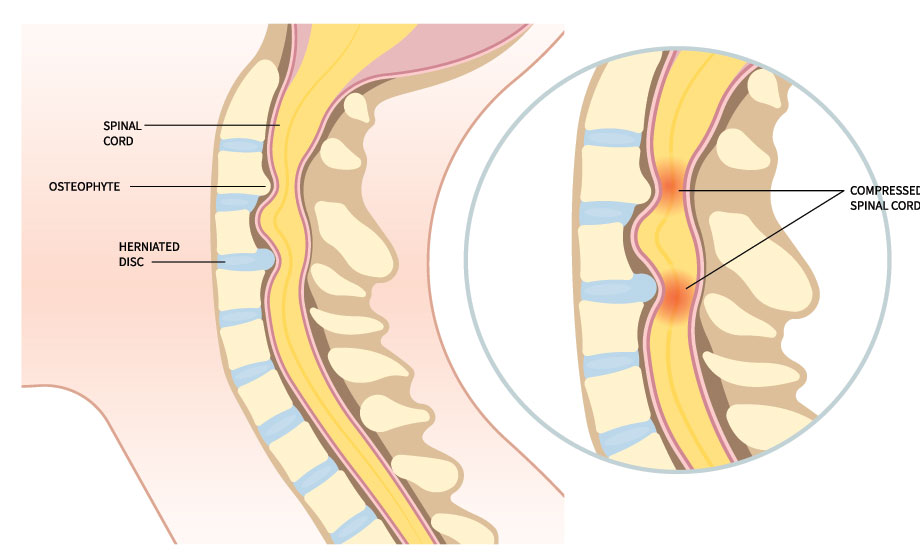
Cervical Myelopathy: A Serious Spinal Cord Condition
Cervical myelopathy is a serious condition where the spinal cord in the neck is compressed. This condition, often linked to cervical spinal stenosis, disc herniation or bone spurs, affects mobility, coordination and daily function. As the spinal canal narrows in the cervical region, it places pressure on the spinal cord, limiting communication with the brain. Symptoms of cervical myelopathy include numbness, weakness, balance issues and difficulty with fine motor skills, often impacting the upper limbs and hands. Without intervention, the condition can progress, leading to a significant reduction in quality of life.
Causes of Cervical Myelopathy
Cervical myelopathy is primarily caused by cervical spinal stenosis, where the spinal canal narrows in the neck region. This narrowing often results from age-related degeneration, leading to:
- Disc Herniation: When the spinal disc protrudes into the spinal canal, it presses on the spinal cord, restricting movement and nerve function.
- Bone Spurs: These bony growths often develop in response to degenerative changes, taking up space within the spinal canal and pushing against the spinal cord.
- Thickened Ligaments: With time, the spinal ligaments may thicken and harden, reducing space in the spinal canal and applying pressure to the spinal cord.
- Trauma: Past neck injuries or damage can alter the structure of the cervical spine, contributing to spinal cord compression.
These structural changes can have serious impacts, limiting nerve function and interfering with the signals transmitted through the spinal cord.
Symptoms of Cervical Myelopathy
Cervical myelopathy presents a range of symptoms that vary depending on the severity and extent of spinal cord compression. Symptoms may include:
- Numbness and Tingling: This is most often felt in the hands, arms or fingers and is usually one of the earliest signs.
- Weakness in Limbs: Muscle weakness, especially in the upper body, is common, often impacting the arms and hands.
- Coordination Problems: Many patients find it challenging to perform tasks requiring fine motor skills, like buttoning clothes or using utensils.
- Difficulty Walking or Balancing: Balance issues may worsen, making it difficult to walk confidently or avoid falls.
- Pain or Stiffness in the Neck: Although not always present, neck discomfort can accompany myelopathy, especially in cases of advanced compression.
Diagnosis of Cervical Myelopathy
Proper diagnosis of cervical myelopathy involves a thorough examination and advanced imaging. An MRI is frequently used to determine the extent of spinal cord compression, while X-rays or CT scans provide structural details and can help identify causes like bone spurs or disc issues. Diagnostic tests enable specialists to assess the severity of compression and guide treatment planning.
Surgical Treatment Options for Cervical Myelopathy
For cases of cervical myelopathy where symptoms impact daily life and conservative treatments provide little relief, surgery may be recommended. Surgical options aim to relieve pressure on the spinal cord and prevent further damage. Common procedures include:
- Laminectomy: In this procedure, part of the vertebral bone, known as the lamina, is removed to expand space around the spinal cord and reduce compression. A laminectomy is often recommended for more severe cases.
- Discectomy:When a herniated disc causes compression, a discectomy may be performed to remove the problematic portion of the disc. This technique alleviates spinal cord pressure, relieving symptoms.
- Spinal Fusion: Often done in conjunction with a decompression procedure, spinal fusion stabilizes the spine by permanently connecting two or more vertebrae. This prevents further narrowing and supports spinal alignment.
Each surgery is based on the patient’s unique condition, anatomy and symptom severity. Post-surgery, patients typically experience improved mobility and symptom relief, allowing a return to daily activities without the challenges of spinal cord compression.
Life After Surgery for Cervical Myelopathy
After surgery, many patients experience a marked improvement in symptoms, especially with mobility, coordination and muscle strength. Surgical intervention for cervical myelopathy not only alleviates current symptoms but also helps prevent the condition from worsening. While recovery times can vary, many patients return to a more active, comfortable lifestyle.
To learn more about Atlantic Spine Specialists surgical options for sciatica, schedule a consultation with one of our specialists Dr. Giordano or Dr. Nachwalter. Contact us today at 973-971-3500!